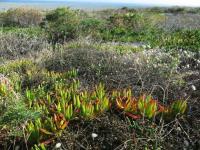
An iceplant, from a region of high diversity in South Africa, is overtopping and killing a native shrub on the New Zealand coast, a region with far less diversity. Dov Sax of Brown University and Jason Fridley of Syracuse University aren't proposing a novel idea to explain species invasiveness. In fact, Charles Darwin articulated it first. What's new about Sax and Fridley's "Evolutionary Imbalance Hypothesis" (EIH) is that they've tested it using quantifiable evidence and report in Global Ecology and Biogeography that the EIH works well.
The EIH idea is this: Species from regions with deep and diverse evolutionary histories are more likely to become successful invaders in regions with less deep, less diverse evolutionary histories. To predict the probability of invasiveness, ecologists can quantify the imbalance between the evolutionary histories of "donor" and "recipient" regions as Sax and Fridley demonstrate in several examples.
Darwin's original insight was that the more challenges a region's species have faced in their evolution, the more robust they'll be in new environments.
"As natural selection acts by competition, it adapts the inhabitants of each country only in relation to the degree of perfection of their associates," Darwin wrote in 1859. Better tested species, such as those from larger regions, he reasoned, have "consequently been advanced through natural selection and competition to a higher stage of perfection or dominating power."
To Sax and Fridley the explanatory power of EIH suggests that when analyzing invasiveness, ecologists should add historical evolutionary imbalance to the other factors they consider.
"Invasion biology is well-studied now, but this is never listed there even though Darwin basically spelled it out," said Sax, associate of ecology and evolutionary biology. "It certainly hasn't been tested before. We think this is a really important part of the story."
Evidence for EIH
Advancing Darwin's insight from idea to hypothesis required determining a way to test it against measurable evidence. The ideal data would encapsulate a region's population size and diversity, relative environmental stability and habitat age, and the intensity of competition. Sax and Fridley found a suitable proxy: "phylogenetic diversity" (PD), an index of how many unique lineages have developed in a region over the time of their evolution.
"All else equal, our expectation is that biotas represented by lineages of greater number or longer evolutionary history should be more likely to have produced a more optimal solution to a given environmental problem, and it is this regional disparity, approximated by PD, that allows predictions of global invasion patterns," they wrote.
With a candidate measure, they put EIH to the test.
Using detailed databases on plant species in 35 regions of the world, they looked at the relative success of those species' invasiveness in three well-documented destinations: Eastern North America, the Czech Republic, and New Zealand.
They found that in all three regions, the higher the PD of a species' native region, the more likely it was to become invasive in its new home. The size of the effect varied among the three regions, which have different evolutionary histories, but it was statistically clear that plants forged in rough neighborhoods were better able to bully their way into a new region than those from evolutionarily more "naive" areas.
Sax and Fridley conducted another test of the EIH in animals by looking at cases where marine animals were suddenly able to mix after they became united by canals. The EIH predicts that an imbalance of evolutionary robustness between the sides, would allow a species-rich region to dominate a less diverse one on the other side of the canal by even more than a mere random mixing would suggest.
The idea has a paleontological precedent. When the Bering land bridge became the Bering Strait, it offered marine mollusks a new polar path between the Atlantic and Pacific Oceans. Previous research has shown that more kinds of mollusks successfully migrated from the diverse Pacific to the less diverse Atlantic than vice-versa, and by more so than by their relative abundance.
In the new paper, Sax and Fridley examined what has happened since the openings of the Suez Canal in Egypt, the Erie Canal in New York, and the Panama Canal. The vastly greater evolutionary diversity in the Red Sea and Indian Ocean compared to the Mediterranean Sea and the Atlantic led to an overwhelming flow of species north through the Suez.
But evolutionary imbalances across the Erie and Panama Canals were fairly small (the Panama canal connects freshwater drainages of the Atlantic and Pacific that were much more ecologically similar than the oceans) so as EIH again predicts, there was a more even balance of cross-canal species invasions.
Applicable predictions
Sax and Fridley acknowledge in the paper that the EIH does not singlehandedly predict the success of individual species in specific invasions. Instead it allows for ecosystem managers to assess a relative invasiveness risk based on the evolutionary history of their ecosystem and that of other regions. Take, for instance, a wildlife official in a historically isolated ecosystem such as an island.
"They already know to be worried, but this would suggest they should be more worried about imports from some parts of the world than others," Sax said.
Not all invasions are bad, Sax noted. Newcomers can provide some ecosystem services — such as erosion control — more capably if they can become established. The EIH can help in assessments of whether a new wave of potential invasion is likely to change the way an ecosystem will provide its services, for better or worse.
"It might help to explain why non-natives in some cases might improve ecosystem functioning," Sax said.
But perhaps Darwin already knew all that.
Source : @brownlifesci
 Print Article
Print Article Mail to a Friend
Mail to a Friend
